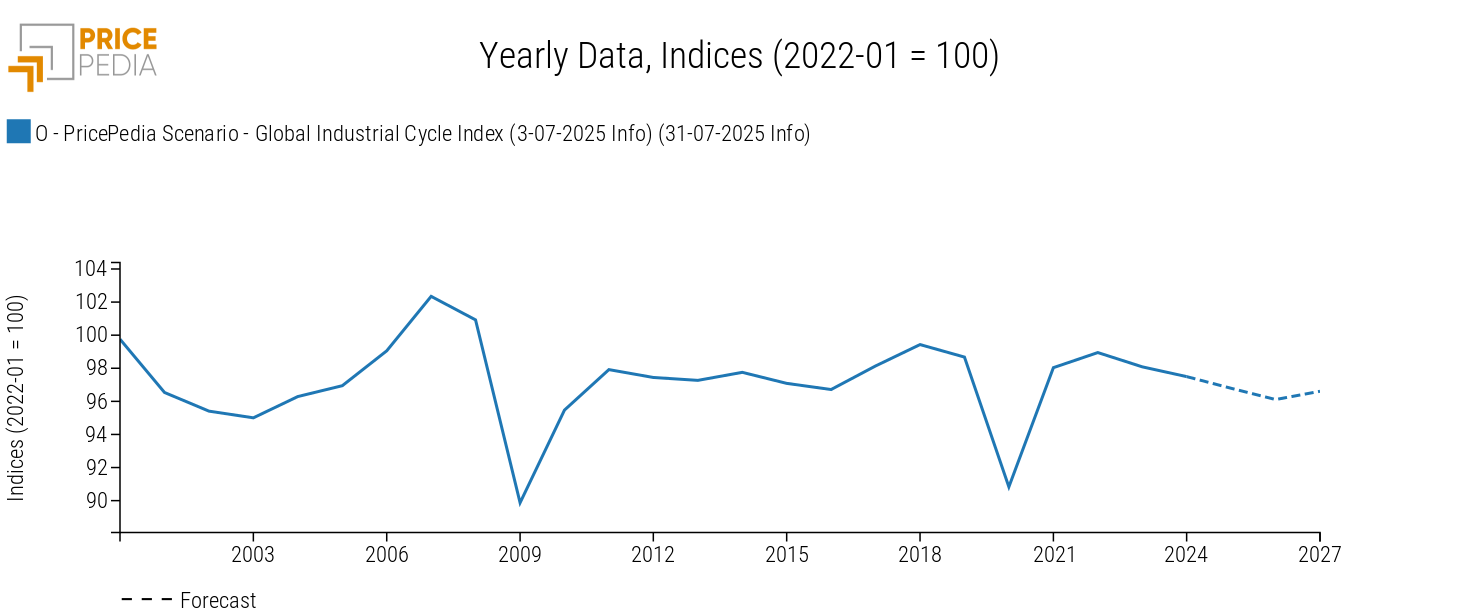PricePedia Scenario for August 2025
Weak commodity demand prevails despite relatively lower trade policy uncertainty
Published by Pasquale Marzano. .
Forecast ForecastThe PricePedia Scenario has been updated with information available as of July 31, 2025. Last week saw the arrival of the much-anticipated agreements between the US and several major trading partners, including the European Union. The agreement with the EU includes a 15% tariff on European products imported by the US (excluding a list of strategic products yet to be defined) and a series of commitments, such as the removal of European barriers to American goods and the EU’s commitment to purchase American energy over the next three years (for more information, see Financial markets once again at the mercy of Trump). Although the agreement is an improved compromise - compared to the 30% tariff that would have come into effect had no agreement been reached before the August 1st deadline set by President Trump - it adds to the long list of deals involving tariff increases on US partners and worsens expectations for a recovery in global trade and economic growth.
This worsening impacts the projected trend of the global industrial cycle over the next two years[1], which has already shown a downward trend since 2022, accompanied by continued weakness in global commodity demand.
Global industrial cycle, August 2025 scenario

Over the next two years, the index is expected to continue its downward trend, with an average annual variation of -0.7%. A reversal of this trend, in annual terms, is projected only in 2027, when the cycle is expected to show a slight increase of +0.5%.
Do you want to stay up-to-date on commodity market trends?
Sign up for PricePedia newsletter: it's free!
Forecast of purchasing material prices
Commodity prices over the next 24 months are expected to reflect the weak dynamics of the global industrial cycle and the corresponding demand for raw materials. In aggregate terms, this translates into an expected average price decrease of -6.1% in 2025 and -6.6% in 2026.
The table below shows the annual percentage changes in euro prices for the main commodity aggregates included in the PricePedia Scenario: Industrial[2], Commodity[3], Energy, and Food.
Table 1: Annual variation rates (%) of PricePedia Aggregate Indices, in Euro
| 2024 | 2025f | 2026f | 2027f* | |
|---|---|---|---|---|
| I-PricePedia Scenario-Commodity Index (Europe) (3-07-2025 Info) (31-07-2025 Info) | −4.53 | −6.07 | −6.61 | −0.56 |
| I-PricePedia Scenario-Energy Total Index (Europe) (3-07-2025 Info) (31-07-2025 Info) | −5.89 | −13.06 | −11.71 | −1.20 |
| I-PricePedia Scenario-Industrials Index (Europe) (3-07-2025 Info) (31-07-2025 Info) | −4.53 | −1.76 | −0.47 | +0.73 |
| I-PricePedia Scenario-Food Total Index (Europe) (3-07-2025 Info) (31-07-2025 Info) | +3.25 | +9.34 | −6.91 | −2.42 |
Breaking down the Total Commodity aggregate into individual subcategories reveals the stronger downward trend forecast for energy commodities, whose prices are expected to decline by double digits over the 2025–2026 period. This price reduction phase is projected to slow during 2027 (-1.2% compared to the previous year).
As for industrial commodity prices, following a nearly -5% drop in 2024, a further decline of -1.8% is expected in 2025. Although average prices in 2026 are projected to decrease by half a percentage point, the monthly trend may show a slight increase starting from April 2026. This trend is expected to consolidate during 2027, leading to a modest annual average increase (+0.7%) in industrial commodity prices.
Although the prices of food products are forecast to rise by nearly +10% on average this year, it's worth noting that the monthly price trend has recently reversed, moving away from the historical peak recorded in March 2025. This downward trend is expected to continue in 2026 and 2027, with projected decreases of -6.9% and -2.4%, respectively.
1. The global industrial cycle index is constructed by purifying the actual dynamics of industrial production from its trend. Since the supply of commodities tends to vary according to long-term economic growth expectations, while the demand for commodities is more linked to actual cyclical uses, the global industrial cycle index tends to reproduce the conditions of tension between demand and supply on the commodity market: when it increases, it means that the demand for commodities increases more than the supply; vice versa when it decreases.
2. The PricePedia Industrials index results from the aggregation of the indices relating to the following product categories: Ferrous, Non-Ferrous, Wood and Paper, Chemicals: Specialty, Organic Chemicals, Inorganic Chemicals, Plastics and Elastomers and Textile Fibres.
3. The PricePedia Commodity index results from the aggregation of the indices relating to industrial, food and energy commodities.


